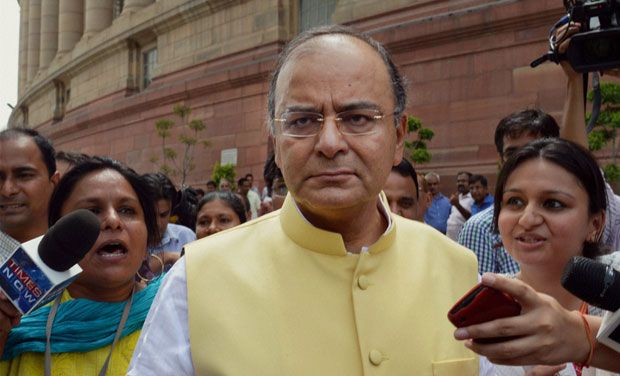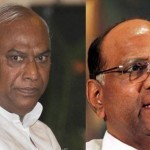
New Delhi: Outlining the roadmap for fiscal consolidation on Wednesday, Finance Minister Arun Jaitley said the government will retain the fiscal deficit target for 2014-15 at 4.1 per cent of GDP and reduce it further to 3 per cent by 2016-17. Finance Minister Arun Jaitley in an interview to a television channel promised to lift economic growth to rates of 7-8 per cent by promoting manufacturing and infrastructure. He also regretted not being able to give more to taxpayers.
Presenting his maiden Budget, the Minister said the prevailing economic situation presents a great challenge and there was a need to introduce fiscal prudence that will lead to fiscal consolidation and discipline.
“My predecessor (P Chidambaram) had set up a very difficult task of reducing the fiscal deficit to 4.1 per cent of GDP in current year… the target in indeed daunting.
“Difficult as it may appear, I have decide to accept this target as a challenge,” he said.
Outlining the roadmap for fiscal consolidation, Jaitley said fiscal deficit would be brought down to 3.6 per cent in 2015-16 and 3 per cent by 2016-17.
The fiscal deficit, which had touched a high of 5.7 per cent in 2011-12, was brought down to 4.8 per cent in 2012-13 and further to 4.5 per cent in 2013-14.
The reduction in fiscal deficit by the UPA government, he said, was mainly achieved by a reduction in expenditure rather than by way of realisation of higher revenues.
Jaitley said there are challenges to lowering the fiscal deficit as the country had two years of low GDP growth, a almost static industrial growth, a moderate increase in indirect taxes, a large subsidy burden and not so encouraging tax buoyancy.
“The task before me is very challenging because we need to revive growth, particularly in manufacturing sector and infrastructure,” he said, adding choice has to be made whether or not to be victims of mere populism and wasteful expenditure.
The Budget raises defence spending by 12.5 per cent to Rs 2.29 lakh crore. Non-plan expenditure for the current year has been estimated at Rs 12,19,892 crore with additional amount for fertiliser subsidy and capital expenditure for armed forces.
The total expenditure estimates stand at Rs 17,94,892 crore. Gross tax receipts will be Rs 13,64,524 crore, of which Centre’s share will Rs 9,77,258 crore. Non-tax revenues for current financial year will be Rs 2,12,505 crore and capital receipts other than borrowings will be Rs 73,952 crore.
The Budget pegs the fiscal deficit for the current fiscal at 4.1 per cent of the GDP and 3.6 and 3 per cent in 2015-16 and 2016-17 respectively.
In an apparent reference to the previous government, Jaitley said slow decision making had resulted in a loss of opportunity and two years of sub-5 per cent growth in the economy has resulted in challenging situation.
He said government intends to usher in a policy regime that would bring the desired growth, lower inflation, sustained level of external sector balance and prudent policy stance.
The Finance Minister said the present situation presents a challenge of slow growth in manufacturing sector, in infrastructure and also the need to introduce fiscal prudence.
The tax to GDP ratio must be improved and non-tax revenue increased, he said while pruning the negative list for levy of service tax.
The government will constitute an Expenditure Management Commission to look into every aspect of expenditure reform. It will overhaul the subsidy regime while providing full protection to the marginalised.
Jaitely said the government would like to introduce the Goods and Services Tax (GST) to streamline tax administration, avoid harassment of business and ensure higher revenue collection.
The Budget proposes to infuse Rs 2.40 lakh crore in PSU banks in which citizens will be allowed direct shareholding.
The Budget sets a target of Rs 8 lakh crore for agriculture credit during the current year and will continue the interest subvention scheme and raise the corpus of rural infrastructure development fund (RIDF) to Rs 25,000 crore.
Towards food security, the government commits itself to restructuring Food Corp of India (FCI), reducing transportation and distribution losses and efficacy of PDS.
Wheat and rice will be provided at reasonable prices to weaker sections.
In direct taxes, the Budget makes no changes in the rate of surcharge for any class of tax payer while continuing the education cess at 3 per cent for all.
As a measure of encouraging infrastructure and construction sectors to revive growth and provide jobs, the Budget provides tax incentives for real estate investment trust and infrastructure investment trust.
In manufacturing, considering the need to incentivise smaller entrepreneurs, it provides investment allowance at the rate of 15 per cent to a manufacturing company that invests more than Rs 25 crore in a year in plant and machinery for three years.
Jaitely also proposed to extend the investment linked deduction to new sectors namely slurry pipelines for transportation of iron ore.
The concessional tax rate of 15 per cent on dividends received by Indian companies from foreign subsidiaries is being continued because it has resulted in enhanced repatriation of funds. There is no sunset date to ensure stability of policy.
To enhance the functioning of income tax department as facilitators, 60 more Ayaykar Seva Kendras will be opened to promote excellence in service delivery.
Taking note of the fact that power supply continues to a major area of concern in the country, the Budget proposes to extend the 10-year tax holiday to undertakings which begin generation, transmission and distribution by March 31, 2017, instead of annual extensions.
As part of financial inclusion mission, a special small savings instrument to cater to the requirement of education and marriage of the girl child will be introduced.
A National Savings Certificate with insurance cover will also be launched to provide additional benefits for small savers. In the PPF scheme, annual ceiling will be enhanced to Rs 1.5 lakh per annum from Rs 1 lakh at present.
In defence allocation, Rs 1000 crore has been set apart for implementing one-rank-one-pension policy. Capital outlay for defence has been raised by Rs 5,000 crore over the amount provided in the interim budget.
The Finance Minister also announced setting up a war memorial, war museum and a national police memorial. For modernisation of state police forces, Rs 3,000 crore has been allocated.
An integrated Ganga conservation mission, called ‘Namami Gange’ is proposed to be set up with an outlay of Rs 2,037 crore for this year.
An NRI fund for Ganga will be set up which will finance special projects. Rs 100 crore have been set aside for ghat development and beautification of river front at Kedarnath,
Varnasi, Haridwar, Kanpur, Allahabad, Patna and Delhi.
A 1,620-km Ganga inland waterway development from Haridwar to Haldia is planned to be completed in 6 years at a cost of Rs 4,200 crore, Jaitley said.


